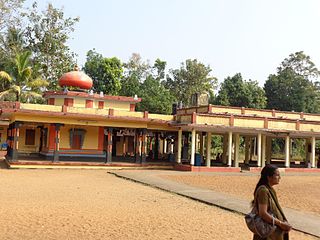
The Parthasarathy Temple is a 6th-century Hindu Vaishnavite temple dedicated to Vishnu in Chennai, India. Located in the neighbourhood of Thiruvallikeni, the temple is glorified in the Naalayira Divya Prabandham, the early medieval Tamil literature canon of the Alvar saints from the 6th to 9th centuries CE and is classified as among the 108 Divya Desams dedicated to Vishnu. The name 'Parthasarathy' means the 'charioteer of Arjuna', referring to Krishna's role as a charioteer to Arjuna in the epic Mahabharata.

Sahadeva was the youngest of the five Pandava brothers in the ancient Indian epic, the Mahabharata. He and his twin brother Nakula were the sons of Madri, one of the wives of the Pandava patriarch Pandu, and Ashvini Kumaras, the divine twin physicians of the gods, whom she invoked to beget her sons due to Pandu's inability to progenate. Kunti, Sahadeva's step-mother, loved him the most despite his birth to Madri. Sahadeva is renowned for his wisdom, knowledge of astrology, and skill in swordsmanship.

Aranmula is a temple town in the state of Kerala, India. It is known as the cultural capital of Pathanamthitta district, located at a distance of around 116 km from Trivandrum, the capital of Kerala, it is situated on the banks of the river Pampa. A centre of pilgrimage from time immemorial and a trade post of eminence, when the river was the chief means of transport, it is near Kozhencherry in Pathanamthitta District. It is easily accessible from Chengannur railway station (10km). It is one of the Fastest Growing Village. Aranmula, along with the majority of Pathanamthitta district, was part of the Quilon division or Central Travancore division of Travancore. On November 1, 1982, Pathanamthitta district was established.

The Vadakkumnathan Temple is an ancient Hindu temple dedicated to Shiva in Thrissur, in the Thrissur district of Kerala, India. The temple is a classical example of the architectural style of Kerala and has one monumental tower on each of the four sides in addition to a koothambalam. Mural paintings depicting various scenes from the Mahabharata can be seen inside the temple. The shrines and the Kuttambalam display vignettes carved in wood. The temple, along with the mural paintings, has been declared as a National Monument by India under the AMASR Act. According to popular local lore, this is the first temple built by Parashurama, the sixth avatar of Vishnu. Thekkinkadu Maidan, encircling the Vadakkumnathan Temple, is the main venue of the renowned Thrissur Pooram festival.

Thrikkakara Vamanamoorthy Temple is one of the major Hindu temples in India dedicated to Vamana, a form of the god Vishnu. It is situated in Thrikkakara, Kochi in the state of Kerala, India. The temple is around two millennia old and is also listed as one of the 108 Divya Desams.

The Aranmula Parthasarathy Temple is a Hindu temple located near Aranmula, a village in Pathanamthitta District, Kerala, South India. It is dedicated to the Lord Krishna, an avatar of Vishnu, who is worshipped as Parthasarathy. Constructed in the Kerala style of architecture, it is one of the "Divya Desams", the 108 temples of Vishnu revered by the Alvar saints.

Thiruvanvandoor is a village Near Thiruvalla, in Chengannur Taluk in Alappuzha district, in Kerala, India.
Thrikkodithanam is a village in Kottayam district in the state of Kerala, India. It is located on the outskirts of Changanassery Municipality.
Ivor Madom Parthasarathy Temple is a popular temple situated in Pampady village near Thiruvilwamala in Thrissur district, on the southern bank of Bharathappuzha, the second longest river of Kerala. The main deity of this temple is Lord Krishna as Parthasarathy, and there are sub-shrines for Ganapathi, Ayyappan, Shiva and Snake deities. The riverside near this temple is famous for performing rituals for dead ancestors. There is also a crematorium, jointly owned by Ivor Madom trust and Thiruvilwamala Grama Panchayat, near this temple.

Ernakulam Shiva Temple, also known as Ernakulathappan Temple, is one of the major temples of Kerala, located in heart of Ernakulam, Kochi,Kerala, India. The temple, dedicated to Lord Shiva, is considered as the city temple, with the presiding deity as the protector of the city, as per local Hindu faiths and traditions. As per the common practice in Kerala, the deity is reverently called Ernakulathappan, which means Lord of Ernakulam. The temple is located within the Durbar Hall Ground. The temple history itself has deep association with history of the city and was one of the 7 royal temples of Kochi Maharajas. The temple is now under administration of Cochin Devaswam Board. The temple in its current form was built under active patronage of Diwan Sri Edakkunni Sankara Warrier in year 1846 and raised it level of a Royal temple in the Kochi Kingdom. The temple is built on 1-acre (4,000 m2) land. The temple is one of the major Shiva temples in Kerala counted along with the Ettumanoor Mahadevar Temple, Kaduthruthy Mahadeva Temple, Vaikom Temple, Chengannur Mahadeva Temple, Vadakkunathan temple, and Sreekanteswaram Mahadeva Temple, Thiruvananthapuram.
Mundankavu is a village situated 2 kilometres (1.2 mi) from Chengannur town centre in Alappuzha district, Kerala, India. It lies on the banks of the river Pampa. It is known as Vadakekkara which is situated on the northern banks of River Pampa. Mundancavu(Mundankavu) ward is part of Chengannur Municipal town.

Pandavatutar Perumal Temple or Thirupadagam located in Kanchipuram in the South Indian state of Tamil Nadu, is dedicated to the Hindu god Krishna, an avatar of the god Vishnu. Constructed in the Dravidian style of architecture, the temple is extolled in the Nalayira Divya Prabandham, the early medieval Tamil canon of the Alvar saints from the 6th–9th centuries CE. It is one of the 108 Divya Desams dedicated to Vishnu, who is worshipped as Pandava Tutar Perumal (Krishna) and his consort Lakshmi (Rukmini.)

Thirumoozhikulam Sree Lakshmanaperumal Temple is located in Thirumoozhikalam (Moozhikkulam) in Ernakulam district of Kerala, India. The temple finds mention in some of verses of ancient Tamil Vedam sung by the Sri Vaishnava Alvars, particularly Nammalvar and Tirumangai Alvar and classified as Divya Desams, the 108 holy temples revered in the canon. This belongs to one of the 13 Malai Naatu (Kerala/Chera) Divya Desams, the Divya Desams located in Kerala.

The Taamaraiyaal Kelvan Perumal Temple or Thiruppaarththanpalli is located close to Thirunangur, a small village, 8 km east of Sirkali en route to Thiruvenkadu and is dedicated to the Hindu god Vishnu. Constructed in the Dravidian style of architecture, the temple is glorified in the Nalayira Divya Prabandham, the early medieval Tamil canon of the Alvar saints from the 6th–9th centuries CE. It is one of the 108 Divya Desams dedicated to Vishnu, who is worshipped as Taamariyaal Kelvan and his consort Lakshmi as Shegamalavalli.

The Thripuliyoor Mahavishnu Temple is a Hindu temple dedicated to Vishnu and located in Puliyoor, Alappuzha District, Kerala, South India. Constructed in the Kerala style of architecture, the temple is glorified in the Nalayira Divya Prabandham, the early medieval Tamil canon of the Alvar saints from the 6th–9th centuries CE. It is one of the 108 Divya Desams dedicated to Vishnu, who is worshipped as Mayapiran/Thripuliyoorappan. The nearest railway station to the temple is located at Chengannur, while the nearest airport is Trivandrum International airport.

The Thiruvanvandoor Mahavishnu Temple is a Hindu temple dedicated to Vishnu and located in Thiruvanvandoor, Alappuzha District, Kerala, South India. Constructed in the Kerala style of architecture, the temple is glorified in the Nalayira Divya Prabandham, the early medieval Tamil canon of the Alvar saints from the 6th–9th centuries CE. It is one of the 108 Divya Desams dedicated to Vishnu, who is worshipped as Paambanaiappan. The nearest railway station to the temple is located in Chengannur, while the nearest airport is Trivandrum International Airport.

Thirumittakode Anchumoorthi Temple is a Hindu temple equally associated with the deities Vishnu and Shiva. Temple is situated on the banks of the Bharathappuzha at Thirumittacode of Palakkad District in Kerala state in India. The five statues - one for Shiva and four Vishnu - are known here as Thirumattikodu five (Anchu) Moorthy Temple.

The Sundaravarada Perumal Temple in Uthiramerur, a village in the South Indian state of Tamil Nadu, is dedicated to the Hindu god Vishnu. Constructed in the Dravidian style of architecture, the temple. Vishnu is worshipped as Sundaravarada Perumal and his consort Lakshmi as Anandavalli. The temple was originally built by Pallavas, with later additions from the Cholas, Pandyas, Sambuvarayas, Vijayanagara Rayas and the Nayaks.

Thrikodithanam Mahavishnu Temple is a Hindu temple dedicated to Vishnu and located in Thrikkodithanam, Kottayam District, Kerala, South India. Constructed in the Kerala style of architecture, the temple is glorified in the Nalayira Divya Prabandham, the early medieval Tamil canon of the Alvar saints from the 6th–9th centuries CE. It is one of the 108 Divya Desam dedicated to Krishna, an avatar of Vishnu, who is worshipped as Mahavishnu. The nearest railway station to the temple is located in Changanassery, while the nearest airport is Cochin International Airport.



















